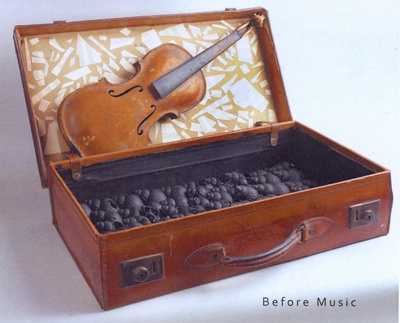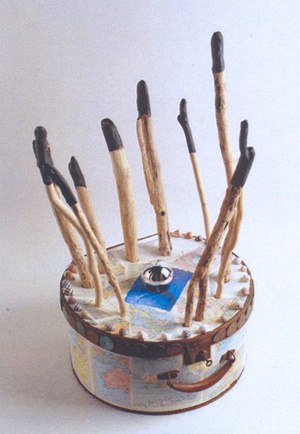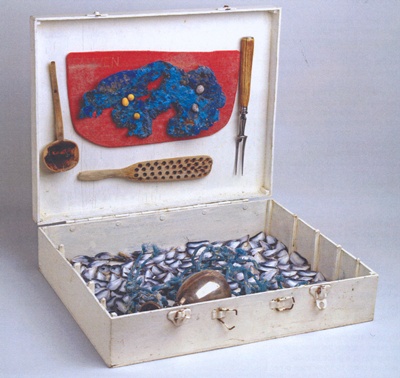23.10.09
Space/Gofod
A statement by artist Stuart Evans in relation to box constructions and other objects he is displaying at the National Library of Wales from 1 September until 29 November, 2009.
Most people collect things. Our lives are filled with objects, curiosities, trinkets, gadgets. We fill our homes with all sorts of collections, items which remind us of our past, our travels, our family. Even the most minimal of homes has a collection of photographs, books or ornaments which decorate the surroundings. We like to make the place personal.
‘These things are not a random collection. They have been gradually accumulated as an expression of that person or household. Surely if we can learn to listen to these things we have access to an authentic other voice. Yes, also contrived, but in a different way from that of language.’
Daniel Miller ‘The Comfort of Things’ 2008.

In the animal world creatures urinate on their patch so as to personalise it, we mark our boundaries in a more complex way, although some artists have used this method to express themselves too. We are all animals after all! But we humans, we tend to go a bit further with our beliefs and practices.
Even from a humble pebble collection gathered by early man (which informs him about his surroundings) there has been an attempt at understanding through collection and study. We have always attempted to find out more about the world.
Similarly we collect stories or relate personal happenings. Often the stories become embroidered so as to make them more interesting or intriguing. We interpret facts and events so as to engage people and their imaginations. Just look at our film industry, it is full of stories.

But if we step back and consider the history of object collecting we eventually come to the basic ‘cabinet of curiosities’. These might be described as the first museums. Filled with wonderful and fascinating objects these collections in glass cabinets were created to help us to try and understand our world.
‘If there were no human beings on earth stones would still be there, But they would not be ‘stones’ because there would be neither mineralogy nor language with which to distinguish and classify them. Natural history specimens are therefore as much social construction as spears or typewriters and as susceptible to social analysis.’
S.Pearce 1992
People have travelled all over the world bringing back treasures. Besides the wonders of nature ˗ collections of stones, shells, fossils, plants, animals ˗ all types of art have also been collected and studied.
In some cases human remains have been collected, admired and displayed. Churches gathered relics of dead saints and displayed them. It became fashionable to collect. Some items are kept for luck, to ward off evil and have other more thought provoking associations.
If you have something unique it is assumed to be more valuable. We are still doing it. Look at any gallery or museum.
We are still attempting to understand ourselves through objects.
Building up a collection of objects and working on it over a period of time is a complex process. When an object is selected and removed from its normal surrounding it changes its meaning, its use. When a table or chair is brought into a museum or gallery it is no longer necessarily functional. They are there to be studied and looked at.
Marcel Duchamp opened a can of worms by exhibiting the ‘ready made’. But he got us thinking.
When a urinal is placed on a plinth it means something different, we see it again. When a knife is placed next to a fork it signifies something, when it is placed next to a blood stained garment it signifies something else. A pile of bricks in a gallery can shock. Placing objects creates meaning.
Is this true too of all art objects? Are they created for the gallery or museum environment? Do they transport us into another world or help us to see and understand this one? When a religious painting is viewed not in a church is but a museum, is that object changed? When two people stand next to each other viewing a ‘Madonna and Child’ in a church what is going on in their minds? Spiritual belief and prayer, or artistic appreciation?
Many artists have used objects and created constructions, the most famous being the American, Joseph Cornel (1903-1972). Besides spending time collecting and constructing he hardly ever showed his work in his lifetime.
‘Cornell’s boxes are not there to be read, so much as rooted through, like an old trunk in the attic’.
Blake Morrison 2008
Cornell is less well known for his film making. But again he questions our understanding of the object, and of course with film he also introduces the element of time into the equation.
Films by Maya Deren and Stan Brackhage, associates of Cornell, work with notions of object and history in a symbolic way. Joseph Cornell described his work as the natural outcome of his love for his home and his life’s experience. Look too at the work of painter and film maker Peter Greenaway and his more recent web work in the Tulse Luper project. He too has a fascination with objects and museums, with the order of things and the meaning of memory and history. Following on from here you might even attempt to struggle with the work and understanding of Joseph Beuys and his performances.

Today artists, as well as performers, are playing with installations and environment in a way not previously thought of, and it is the role of the artist to question and throw new light on what has gone before.
I have worked in a social history museum for over thirty years. The present collection of 55,000 objects might not be of any significant monetary value but they are collected so as to represent the history of a county, Ceredigion in mid Wales. This sort of collecting and displaying is happening all over the world. By comparing ourselves with others we can focus on who we are.
Through my own observations of displaying and interpreting objects I have come to some conclusions about what it means to present objects to others. The objects, whether they be ‘ready mades’, constructions or fine art works, usually remain the same but we humans constantly change ˗ that is what life is about. Our understanding and interpretation of these collected objects change and should do. With time we move forward and the objects belong to our history which is always up for interpretation. We might consider history to be fixed but our understanding of that history is not. It is a constant struggle to find a way through.
‘It is the responsibility of the artist to penetrate the past and unmask the present’.
Robert Hewison, The Heritage industry 1987
A display of Stuart Evans box constructions will be showing at the National Library of Wales from September1st until 20 November 2009
Stuart Evans 2009: [email protected]